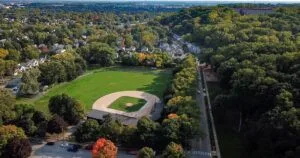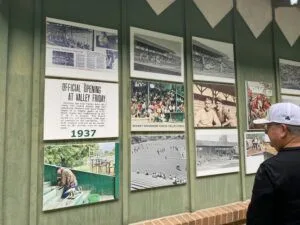The aging Sullivan Field on Grand Rapids’ west side — once home to baseball legend Satchel Paige and at least 70 other players who went on to the major leagues — is set for upgrades that will put the ballpark’s illustrious history on display.
The unassuming field, which originally went by the name “Valley Field,” is tucked away in a residential neighborhood at 650 Valley Ave. NW. Owned by the city of Grand Rapids, the baseball diamond is classified as a neighborhood park and serves as the home field for Union High School as well as several men’s baseball leagues.
The city is using $1.2 million from a 2019 parks millage to repair the roof and iconic green grandstands at Sullivan Field. Rockford Construction Co. is the construction manager for the project, which is expected to begin in the next several weeks and wrap up in the fall or spring of 2024, said Karie Enriquez, project manager for the city’s Parks and Recreation Department.
Keep up with all things West Michigan business. Sign up for our free newsletters today.
The field was constructed in 1937 using Work Projects Administration funds and, until recently, was only used for baseball games. Starting in 2021, the Friends of Valley Field nonprofit has held a wide range of events at the ballpark, including a performance from the Grand Rapids Symphony, a comedy show and a chili cook-off.

Friends of Valley Field formed at the end of 2020 when Paul Soltysiak heard the city was using money from its park millage to fix up the grandstands at the field. Soltysiak, who serves as vice president and co-founder of the group, saw an opportunity to build on the city’s project and turn the beloved ballpark into a venue for community events that also pays homage to the field’s place in baseball history.
“This was my playground growing up, I was here all the time,” said Soltysiak, who grew up across the street from Sullivan Field. “I have an affinity for the park.”
Friends of Valley Field aims to raise another $3 million for the renovation project, putting the total project at $4.2 million in private and public funds. The nonprofit is working to raise money through naming rights throughout the park, including banners that hang in the outfield, as well as food and beverage sales and admission charged at some of the events. The revenue streams would be in addition to various private donations and grants.
The city supports Friends of Valley Field’s involvement with the project, Enriquez said.
“It takes the work we’re able to do and magnifies it quite a bit,” Enriquez said. “Our millage is a set amount of money, and it’s a nice amount of money, but because of all the parks we have, it’s a limited amount. Having this group get additional funds for the park is huge. They also have more knowledge of the park space because a lot of the people involved have played there and been around the park for decades. They know all the improvements everyone wants to see.”
The first anticipated upgrades include refurbishing the grandstands, replacing the dugouts, upgrading the roof and replacing the chain link fence that separates the fans from the field with netting that is now more commonly used and makes it easier to watch ball games, Soltysiak said.

More than baseball
Friends of Valley Field has secured various private and public funding sources so far for the project, including a $1.05 million allocation from the latest state budget. The nonprofit also generates revenue from the concessions at community events that have taken place at the field over the years, Soltysiak said.
“We want to make money (at the events), but if we break even or even lose a little money on an event, we don’t care because we’re trying to get people in here and let people enjoy it, and give the park exposure,” Soltysiak said.

The group aims to preserve the history of the field and continue its use for baseball, but also to make the park more of a public gathering space for events, said Jim Krzeminski, who serves on the advisory board of Fans of Valley Field as the capital campaign leader. Krzeminski is also the former president of Walker-based Bissel.
“We really want to restore the history but look forward to making it a premier public space in the city,” Krzeminski said. “When you bring that confluence of all that emotion together and that excitement, that’s why you see that love and passion for the project.”
After the grandstands and roof, the next priority will be upgrading the infield, installing a new main entrance to the park along Valley Avenue, and refurbishing the locker rooms. As well, Friends of Valley Field also plans to install a walk-through museum that will contain historic photos and display boxes highlighting players and teams that have played on the field over the years.
The Grand Rapids Sullivans, who were owned and managed by Bob Sullivan, used the park as their home field and went on to win four National Amateur Baseball Championships. The field was renamed in 1996 to honor Sullivan. The American Seating Co.-sponsored team, The Seaters, also played on the field, as well as several Negro League teams, most notably the Grand Rapids Black Sox owned by Ted Rasberry, the Chicky Candy Bar Giants owned by Frank Lamar, and The Colored Athletics owned by Jess Elster.
As well, Detroit Tigers legends Al Kaline, Mickey Stanley, Kirk Gibson and Dave Rozema all once played on Sullivan Field.
“Everybody growing up knew (Sullivan Field) was the place, the hub for the West Side,” Krzeminski said. “If you wanted to be a major leaguer, you went through Valley Field, that little gem on the West Side.”

‘A piece of the past’
The Sullivan Field project also will likely re-energize a younger generation’s interest in baseball, as well as an interest in the history of baseball in Grand Rapids, said George Bayard III, the executive director of the Grand Rapids African American Museum and Archives (GRAAMA).
Historically, the field hosted many great Black baseball players from Negro League teams, as well as notable white players on teams like The Sullivans, Bayard said. Those teams would sometimes play against each other.
“They were playing wherever they could,” Bayard said. “Most of the players just want to go up against the best.”
While some players from the Negro League teams in Grand Rapids are alive today, they are aging and it is important to get their stories on record, Bayard said. Grand Rapids resident Minnie Forbes was not a player, but she was a bookkeeper for her uncle Ted Rasberry’s team, the Grand Rapids Black Sox, and went on to buy the Detroit Stars from him.
The GRAAMA is working with Friends of Valley Field to help provide some of the local history of Black baseball for the museum part of the project, he said.
“The field itself, I’d like to see it just be revitalized and then have at least a decent sustaining crowd that comes through there on a regular basis when it’s up and running,” Bayard said.
Other ballparks in town hosted these teams in the past, but Sullivan Field is the primary facility remaining with a true grandstand. It also was one of the few fields, and perhaps the only, at the time that was enclosed, meaning teams could charge entry fees, Bayard said.
“We’re losing more places like (Sullivan Field) than we’re gaining,” Bayard said. “That has a rich history regionally and since both white and Black teams played there, there isn’t another place like that. … Old ballparks are just a piece of the past.”
More from Crain’s Grand Rapids Business:
MoTown Square $18M assisted living project preps for groundbreaking
Grand Ventures raises $50M for second investment fund
Steelcase Foundation invests $500K in minority-focused venture capital fund


